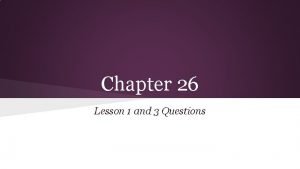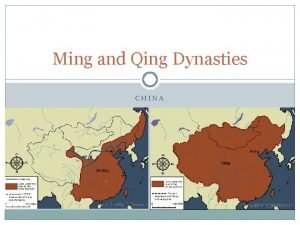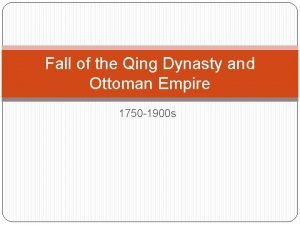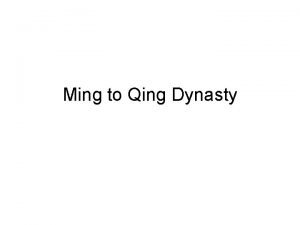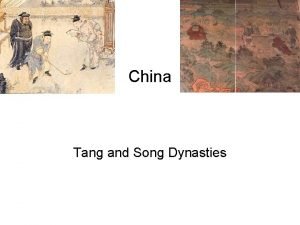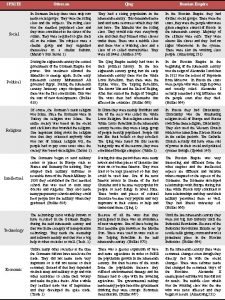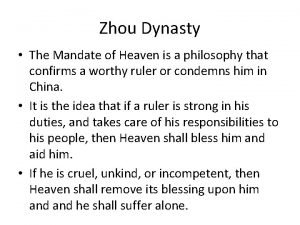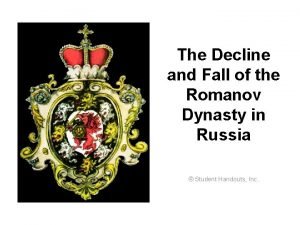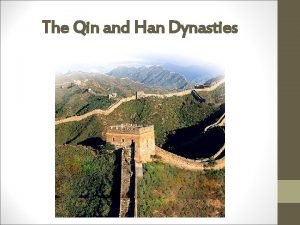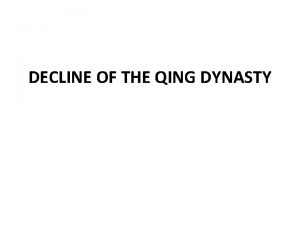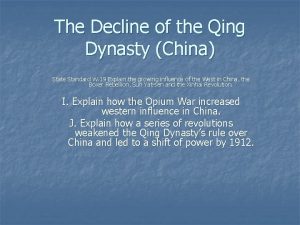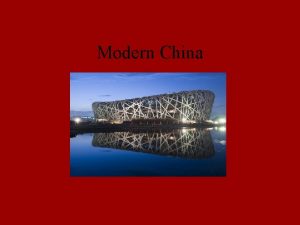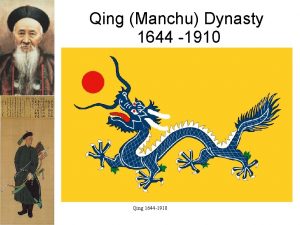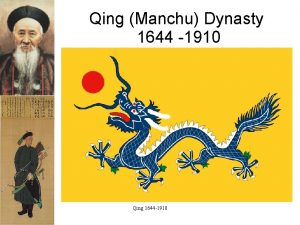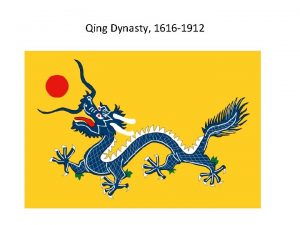The Decline of the Qing Dynasty China State













- Slides: 13

The Decline of the Qing Dynasty (China) State Standard W. 19 Explain the growing influence of the West in China, the Boxer Rebellion, Sun Yat-sen and the Xinhai Revolution. D. Explain how the Opium War increased western influence in China. E. Explain how a series of revolutions weakened the Qing Dynasty’s rule over China and led to a shift of power by 1912.

D. Explain how the Opium War increased western influence in China. • Prior to the Opium War (1839 – 1842) China was isolated much like Japan. • They had opened few ports to British trade but wished to maintain historic traditions. • Due to the minimal trade, the British had a trade deficit with the Chinese. • When the Chinese were unwilling to allow more British imports, the British turned to trading Opium from India to the South Chinese.

D. Explain how the Opium War increased western influence in China. • Realizing that opium was highly addictive and causing social problems in the southern region, the Chinese attempted to use force to stop the opium trade. • In 1842, the Chinese were forced into the Treaty of Nanjing, which forced them to pay reparations, give up territory including Hong Kong, and open five ports to other nations, including France, Germany, Japan, and the United States. – This marked the start of a period of extraterritoriality, where foreigners lived in China but did not abide by its laws. – Western influence of China had begun.

E. Explain how a series of revolutions weakened the Qing Dynasty’s rule over China and led to a shift of power by 1912. • For the next 70 years, the strength of the Qing Dynasty was weakened through a series of rebellions and civil unrest in China. – Tai Ping Rebellion (1850 – 1864): Christian convert Hong Xuiquan attempted to overthrow the Qing dynasty, killing 25, 000 innocents in one battle. The British helped re-establish the Qing.

E. Explain how a series of revolutions weakened the Qing Dynasty’s rule over China and led to a shift of power by 1912. • Rebellions continued: – Boxer Rebellion (1899 – 1901): After the Qing Dynasty established an Open Door policy to the west, members of a secret shadowboxing organization became upset with the growing influence of the west and poor economic conditions. – In response, the Boxers began to roam the country side to “destroy the foreigner” and slaughtered thousands of foreign missionaries and Chinese Christians. – In response, an allied army consisting of those nations with an interest in China, put down the rebellion.

E. Explain how a series of revolutions weakened the Qing Dynasty’s rule over China and led to a shift of power by 1912. • After the Boxer Rebellion, the Qing dynasty attempted one last time at enlightened reform, but failed for 3 reasons: • The dynasty’s slow pace of reform upset the emerging new elite. • The newly created assemblies (legislature) could not pass laws, but only advise the emperor. • Living conditions for the lower class were also worsening.

Revolution in China • State Standard W. 19 Explain the growing influence of the West in China, the Boxer Rebellion, Sun Yat-sen and the Xinhai Revolution. F. Why did Sun Yat-sen form the Nationalist Party? G. How did the Xinhai Revolution transform China?

F. Why did Sun Yat-sen form the Nationalist Party? • In 1905, radical leader Sun Yat-sen formed the Revolutionary Alliance, which would later be known as the Nationalist Party. – Sun Yat-sen knew the Qing Dynasty was on the brink of collapse. – China needed a new government in place to protect China from completely falling under control of the imperializing nations. – Sun Yat-sen believed it was his responsibility to prepare the Chinese people for democracy.

F. Why did Sun Yat-sen form the Nationalist Party? • Sun Yat-sen set out a three-stage process to reform China: – Step 1: military take-over – Step 2: prepare the people for a democratic government – Step 3: establish a new constitutional democracy. • However, in 1908, before the reform process could be carried out, Empress Dowager Ci Xi died, leaving the “last emperor, ” infant Henry Pu Yi at the throne.

G. How did the Xinhai Revolution transform China? • In October 1911, while Sun was in the U. S. , his followers launched an uprising in Central China and the Qing Dynasty officially collapsed. • Sun and his party were in no position to form a new government and did not have a military large enough to back them. • They turned to General Yuan Shigai (initially backed the Qing), who would become the president of the new “democratic” government.

G. How did the Xinhai Revolution transform China? • Yuan was distrusted by many, even his closest allies, and understood little about the new reforms the people wanted. • Yuan dissolved the newly created parliament and ruled through violence. • After Yuan’s death in 1916, civil war erupted between Yuan’s officers and Sun’s National Party.

G. How did the Xinhai Revolution transform China? • Although civil war had emerged, the western nations had managed to introduce industrialization and change the culture of China. • Although Chinese society was still mostly based on agriculture, Chinese cities were booming with factories and western culture. • However, most profits were still going back into the pockets of the imperializing nations.

• Complete p. 260 # 1 -5
 Chapter 26 lesson 1 the decline of the qing dynasty
Chapter 26 lesson 1 the decline of the qing dynasty Qing empire decline
Qing empire decline Qing qing ting lyrics
Qing qing ting lyrics Qing dynasty location
Qing dynasty location Ming dynasty time period
Ming dynasty time period Fall of qing dynasty
Fall of qing dynasty Qing dynasty dbq
Qing dynasty dbq Golden ages of china tang and song dynasties
Golden ages of china tang and song dynasties Qing dynasty at its height
Qing dynasty at its height Qing dynasty social classes
Qing dynasty social classes Which dynasty introduced the mandate of heaven
Which dynasty introduced the mandate of heaven The decline and fall of the romanov dynasty
The decline and fall of the romanov dynasty Qing china at its height
Qing china at its height Four chinese dynasties
Four chinese dynasties
